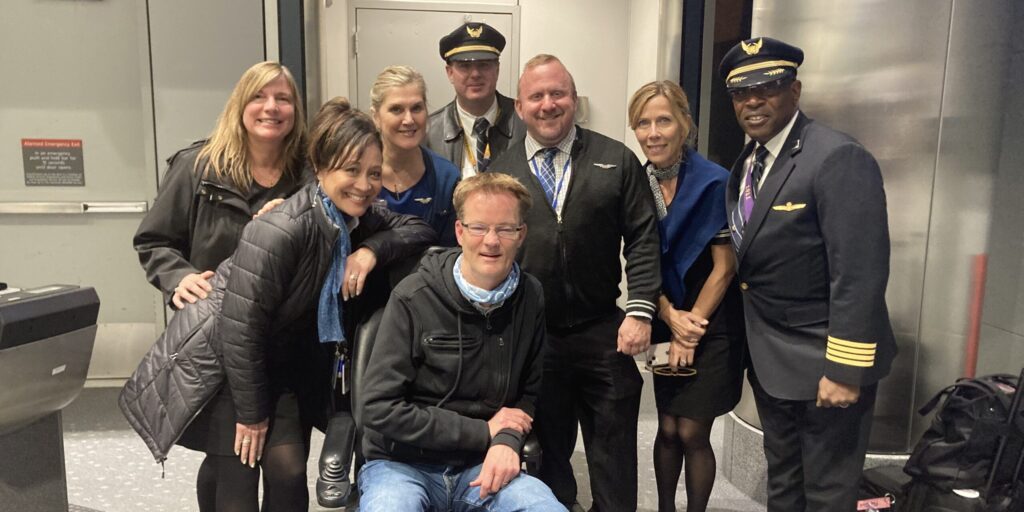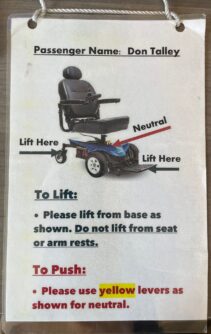
Airplane Travel Tips from a One Million Mile Traveler
By Don Talley | Wednesday, December 13, 2023

Don Talley is a wheelchair user who has flown over one million miles.
In March of 2023, I boarded a United flight from San Diego, California to Denver, Colorado. It was a beautiful day to fly. Flying was rather routine for me, as I had flown over 1,000 times before. On this flight, right before departure, the pilot announced a thank you and congratulations to one of the passengers for reaching a significant milestone: one million miles flown. That passenger was me, and that flight was my million-mile flight.
I never imagined I could have flown so much, especially with the added complexities of my diagnosis. I am a person who has a rare form of congenital muscular dystrophy and I’ve been a member of the MDA Family for as long as I can remember. I use an electric wheelchair and have very limited mobility when using my knee-ankle-foot orthotic braces (KAFOs) to stand.
Most of my flights have been domestic with a spattering of international travel. I have traveled solo, with a companion, with my family, and even with larger groups. I have certainly had my share of unfortunate events while traveling, including my wheelchair being broken or left in my departure city (now I have an Air-Tag on my chair), having to be carried down the aircraft stairs, being left in the rain because of broken airport equipment, and delayed or cancelled flights. The potential of something going wrong and having to manage or adapt to a difficult situation is reason enough to stay home. However, by knowing the tricks of the trade, you can minimize risk when traveling by plane, and not miss out on all of the fun that traveling can bring.
If you are reading this and preparing for holiday travel in the coming weeks or are considering a bucket-list trip with friends, the following tips should help to make your trip much more enjoyable and smooth.
Tips for traveling with a disability
The absolute first thing you should do is join your airline’s reward program. Most airlines have a frequent traveler program and becoming a member is easy and convenient. Don’t get hung up on the word “frequent traveler” either; there are several benefits to doing this even if you’re only planning one trip at a time. For instance, by becoming a General Member, you will have priority over non-members when it comes to flight changes, cancellations, and, in some cases, seating. However, the biggest benefit to becoming a member is that you can build a profile that is linked to your member number. Your profile provides valuable information for the airline, including your seating preferences, your mobility and boarding needs, the type of mobility equipment you will bring with you, and so much more. Make sure you do this for your whole family. Not only will you all begin to earn rewards, but it also makes it very easy to use the airline’s app for changing seats, tracking baggage, managing boarding passes, using the onboard WIFI and entertainment system, and staying up to date with gate changes.
Secondly, you should understand that the airline and airport staff generally really do want to be helpful and will accommodate you and your family as much as possible. Typically, after booking my ticket I contact the airline’s reservation number and ask to speak to their disability desk. There, I can request changes to seat assignments, as most major carriers block seats in premium rows for passengers with disabilities. I also verify that my boarding needs are in the record and that they will be ready for me to board using an aisle chair. And it is a little known fact that some airlines will actually allow you to bring two wheelchairs on the trip – a manual wheelchair and an electric wheelchair at no extra charge. This can be helpful if your destination doesn’t have wheelchair accessible ground transportation easily available. Additionally, the airport has staff available to assist you through security and to your gate. Just ask when you check in at the main terminal. They will help with carry-on bags, guide you through the wheelchair security line, and make sure you and your family get to your plane.

A laminated tag provides instructions for the airline staff to properly handle Don’s power wheelchair.
Thirdly, I have learned to over communicate when it comes to leaving my durable medical equipment in the hands of the airlines. When I arrive at the gate, and prior to boarding, I speak to the gate agent and reconfirm that I require pre-boarding and an aisle chair on the aircraft. They typically fill out a form and ask questions about the weight of my chair and the type of batteries it uses. I show them a laminated 5×7 picture of my chair hanging from the headrest. This homemade craft has simple instructions for putting the chair in neutral and how to lift it safely. This placard has been a wonderful tool for me and the airline because the highest risk point for damage seems to be when they lift the chair in and out of the cargo area.
Lastly, choosing the right airline and sticking with them for all future travel is really helpful. Many of the major airlines have partnered with a company named Global Repair Group (GRG). This company has a vast network of wheelchair and medical equipment repair technicians in cities across the USA, and some international locations as well. Having a third-party company steward the repair needs of our equipment (assuming the incident was caused by the airline) is a gamechanger for the industry. It should bolster your confidence that if something goes wrong, the airline and GRG has it covered. For example, I landed in Dallas and my wheelchair was inoperable. The airline submitted the claim and within 30 minutes I was on the phone with GRG. They dispatched a local repair technician, and I was back up and running in less than an hour. If needed, they can coordinate loaner equipment if repairs need to wait until you return home. I would recommend visiting GRG’s website to see if your airline is a partner with them.
Travel can be challenging for anyone, but, in my experience, partnering with your airline in the right ways as an informed traveler can really help minimize risk and reduce the stress and anxiety of traveling with a disability. Preparation and communication can significantly help airlines to go the extra mile for you… and in some cases, 1,000,000 extra miles.
Next Steps and Useful Resources
- Stay up-to-date on Quest content! Subscribe to Quest Magazine and Newsletter.
- Join the MDA Advocacy Team’s efforts to make air travel more accessible at MDA.org/AirTravel.
Disclaimer: No content on this site should ever be used as a substitute for direct medical advice from your doctor or other qualified clinician.




